"Why are the sounds we play in our apartments always music?" asked the Danish architect and designer Verner Panton, "aren't the sounds of a chicken farm, waves, the wind and many other things just as beautiful?"1
Questions that force one to question the difference between 'sounds' and 'music', but for all to question our relationships with the myriad 'noises' that accompany daily life.
With the exhibition Sound Sources. Everything is Music! the Weltkulturen Museum, Frankfurt, provide a space for approaching such questions.......
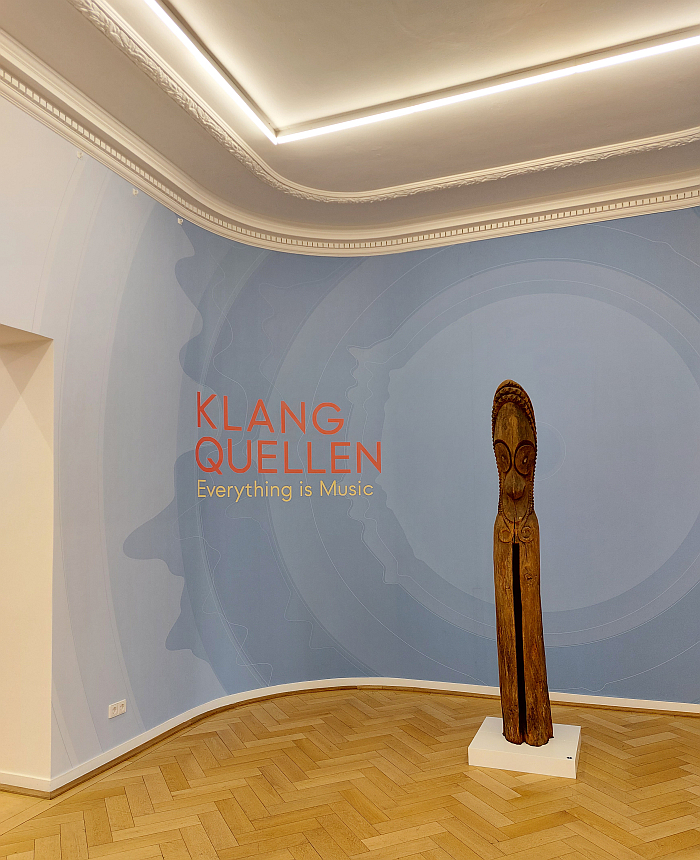
.......or perhaps more accurately provide a soundscape, an arrangement of soundscapes, within which to approach such questions.
Soundscapes that explore everyday sounds in their variety and variation, or, and again more accurately, explore the everyday sounds of human life and work and play in their variety and variation, for while the natural sounds of the wind, the waves and the chickens of a Panton's questioning, observing, challenging, are audible, they are very much on the margins, the primary focus is the everyday sounds of human life and work and play, those sounds we generate intentionally as a component of human life and work and play and those that arise as inescapable consequences of that life and work and play.
Soundscapes including those associated with industry, whereby the focus of Sound Sources. Everything is Music! is less the thumping and banging and grinding of heavy industry, that soundscape which so influenced and informed bands like Die Krupps or Einstürzende Neubauten in the creation of their soundscapes, but those of craft, the sounds of traditional industry, including, for example, brief discussions on the linguistic and cultural links in Flores, Indonesia, between the rhythm of the tenun hand-weaving looms and the tenun cloth produced from that rhythm, or the information traditionally transmitted on Sulawesi, Indonesia, by the rhythm of the pounding as to at what stage production of barkcloth has reached; unconscious wordless communication innately understood. Or soundscapes discussing the varied and various sounds of traditional global agriculture be that, for example, the alo sore rice pounder from Flores which has a clave that allows it to be used as much as a musical instrument as a practical tool; the Goaßlschnalzen practice of Bavaria and neighbouring alpine regions, that cracking of a long coach-drivers whip by way of communicating with residents of a village and/or other road users; or the sounds made on the surface of the Pacific Ocean by the shark fishermen of New Ireland by way of luring their prey. And a 'New Ireland' arguably just as 'new' as that other 'Ireland', and thus an apposite and important reminder of how our European understandings of the world and its ways came to be established, fortified and so damaging. And also by a large collection of cowbells, from, and amongst other locations, Ethiopia, Bali or Germany.
A collection of cowbells that in their geographic range allows access to appreciations that disparate and isolated peoples often, ¿invariably?, develop the same solution to a problem, and thereby if there might not just be something true in a Plato's position of the archetype as a perfect form of which all human objects are but poor interpretations; cowbells that in their variety of materials allow access to considerations on the relevance, value, of the local in global solutions. And cowbells that as the curators note, certainly in context of the larger and metal ones favoured by alpine herders, aren't just objects of discomfort and stress for the cows, but objects of discomfort and stress that cows don't actually need in our contemporary European society. The cows of the alps could be GPS tagged and virtually tracked. But aren't on account of the cultural significance of the cowbell in alpine regions, the cowbell as part of the soundscape of the alpine region. Thoughts which openly challenge you to pose the question, what is more important, the cows or the people? For whom is daily life on the alpine alm designed, the animals who live there or the humans who live there and those humans who visit there? For whom is the alpine landscape maintained? For whom is the alpine soundscape maintained?
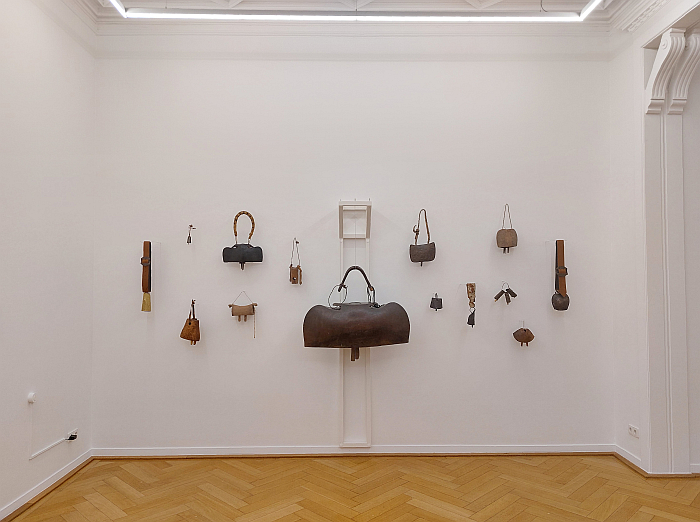
Thoughts on cowbells as unchanging, fixed, unalienable, components of a cultural identity that lead into reflections on the fact that the soundscapes of human life and work and play continually change; thoughts amplified.... sorry!!... in the so-called Museum of Lost Sounds, a discussion on those sounds that were once so familiar, but have long since vanished from our European soundscape, including, for example, an analogue wooden coffee grinder, a rotary dial telephone, or a bubblegum machine that one is encouraged to use, we didn't but we do hope that not only the mechanical noise of the machine but also the noise of individuals aggravated because the promised bubblegum failed to appear is part of the experience, because it always was. And a Museum of Lost Sounds that also features tablets that allow one to access Daniel Chum and Jan Derksen's Conserve the Sound archive, an archive of lost, or certainly rapidly fading, quotidian sounds; if one must add, a very technology, a very post-1945 technology, heavy archive, and one where the inclusion of the Simson Schwalbe motor scooter tends to locate the archive very much in western Germany, locates it geographically nearer Frankfurt (Main) than Frankfurt (Oder): the DDR may be no more but the Schwalbe is a regular, and very audible, visitor to the streets and lanes and alleys of eastern Germany. A confusing of a land for its artefacts that is very informative in context of developments in Europe post-1989. And a locating of the archive, and thus the world conserved through the sounds, in the (historic) west of the contemporary Germany also implied by the notable lack of the letters V, E and B in close proximity to one another amongst the manufacturers represented.2 A subjective locating of appreciations of the world from a fixed perspective very informative in context of the genesis and development of institutions such as the Weltkulturen Museum. As is the 'New' and the 'Ireland' of 'New Ireland'.
And a Museum of Lost Sounds that also helps highlight and focus attention on the fact that that over time we in Europe, east and west, have continually gained new sounds, in most recent years, and amongst others, the buzz of an electric car, the ping of instant messaging systems, Donald Trump, or all those ignorant individuals who believe that their earbuds make them invisible and inaudible and so spend their time shouting in public spaces; the sound, if one so will, of contemporary industry and hybrid working. All those ignorant individuals whose selfish, disrespectful, games of telephone bullshit bingo with their shouting about spreadsheets, deadlines, or what they discussed with Rodrigo and/or Wiebke at their Jour Fixe on Wednesday, make contemporary trains, airports, coffee shops and parks unbearable hells. And shouty individuals invading everyone else's space who beautifully, if violently so, underscore that for all background noise is and always has been a component of human society, it isn't necessarily always agreeable and welcome. Can often be a curse and plague. One can't imagine a Verner Panton extending his deliberations in 2024 to question if a young man shouting into his earbuds about a Jour Fixe isn't "just as beautiful?" as music. For it ain't.
Who'll save us from individuals in white trainers with an exaggerated sense of their own importance, an exaggerated sense of the relevance of their start up, and a universal, and one suspects very lazy, unreflective, unimaginative, fixation with the Jour Fixe!?!? Or perhaps, and thinking about the tenun looms of Flores and the thumping and banging and grinding of 20th century heavy industry: who'll develop a new music from the background noise of contemporary industry and hybrid working to help us make sense of it and its place in contemporary society? Who'll make it into a music as essential for contemporary society's understandings of itself, and future society's understanding of the path taken, and as beautiful, as the clack of a tenun loom or the poetry of Die Krupps or Einstürzende Neubauten. Or must we all wait for the whine of untold thousands of flying cars and delivery drones to not only block out the sky but drown out such individuals, and all sounds of contemporary life? That coming fundamental change to our soundscape, that coming curse and plague, that human society incomprehensibly, unquestioningly, selfishly, is increasingly impatient to have.
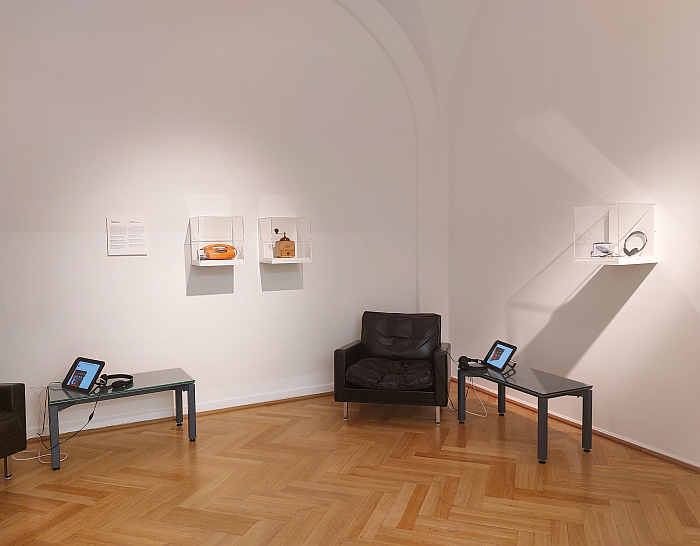
And not just we in Europe have lost sounds, gained sounds and seen our soundscapes change: despite what the images and sounds presented in Sound Sources may lead you to believe, Flores has an airport, Sulawesi is represented in the Indonesian football Liga 1 by PSM Makassar, whose fans' rhythmic pounding is every bit as informative as that of the barkcloth makers, same same but different. And the residents of New Ireland have mobile phones, whereby if the Nokia ringtone, that lost sound of 'Old' Ireland, can still be heard in downtown Kavieng, we no know, having, sadly, never been; however even without having visited Kavieng we, we all, can be certain that there's someone in white trainers in downtown Kavieng shouting into their earbuds about a Jour Fixe. Scaring off the sharks as they do.
And the nomadic tribes of the Mongolian steppe now have cars and motorbikes alongside their horses. Horses that, as one learns in Sound Sources, have not only long been an inherent component of the soundscape of the steppe, but were integral to the development of the music of the region, be that in the form of, the concept of, the morin khuur, the horsehead fiddle, or as inspiration for much of the music of the Mongolian Steppe, not least the gallop of hooves that can be heard, felt, in the rhythms and which when heard, felt, transports you from wherever you are to that Mongolian steppe. And the question naturally posed by such discussions as to whether the gallop of hooves shouldn't now be replaced in the music of the Mongolian steppe by the roar of an engine, much like the rumbling train, both real and implied, in The Jam's Down in the Tube Station at Midnight which takes you from wherever you are to the unhygienic, violence-laced, despair of a late 1970s London Underground station. Same same but different.
Soundscapes ever changing with time, a coming and going over the years, that can also be approached and appreciated in Sound Sources via the so-called Gumboot dance, a dance, one learns, that began in the mines of Apartheid era South Africa as a secretive form of communication amongst workers banned by the mine owners from talking to one another; a secretive language of resistance and self-determination constructed from stamping and slapping their wellington boots. A language that adds a whole new dimension to a Billy Connolly's "If it wisnae fur yer wellies, where wud you be?" A language arising from need and and reality and oppression that today is a dance for entertainment and relaxation. And a Gumboot dance that bears more than a passing resemblance to the thigh and calf and foot and bottom slapping of the Schuhplattler dancing of the Alpine region; or at least possesses a strong physical resemblance, for whereas both seek to ensure a society past isn't forgotten, one is about preserving a perceived romanticised past the other is about maintaining the memory of a brutal reality by way of a warning for coming generations. Same same but different. A same same but different Plato could have predicted. And in that same same but different an important, and highly informative, contribution to the question of what is the role and function of preserving/maintaining expressions of a culture? ¿Conserving an (invariably) romanticised past? ¿Remembering a world that is no more? ¿Underscoring what has been lost and won over the centuries by way of enabling a discussion on the path of (hi)story? ¿Guiding a way forward? ¿Nationalism and identity politics? ¿Commerce? ¿¿??
And which, yes, does bring us back, once again, to cowbells.
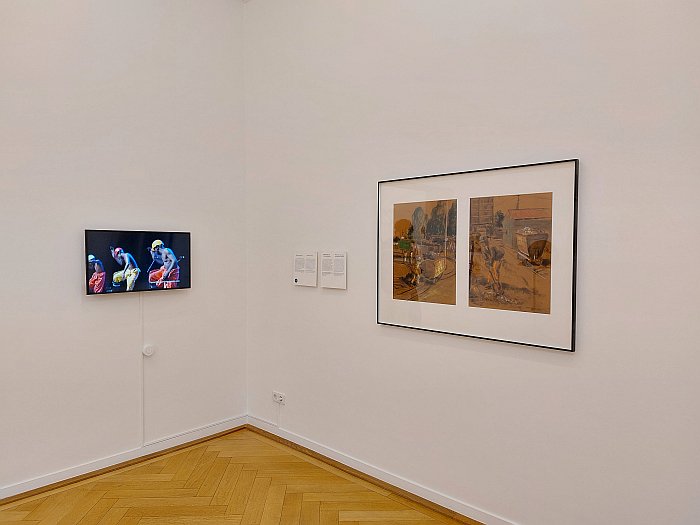
Lost sounds, new sounds, changing sounds, cowbells, that help Sound Sources remind us all that our world today sounds very different from that of 50, 100, 200 years ago. Not completely different some sounds have prevailed, with the very obvious questioning, as implied above, of why some have and others haven't, if it is correct that they have prevailed; a questioning all too often not undertaken. Especially not by conservators, whether building or landscape, professional or amateur.
And appreciations that our world today sounds very different from that of 50, 100, 200 years ago that should be obvious, is obvious, but which we all need to be reminded of, a fact that leads you towards an appreciation that in terms of soundscapes we don't notice the changes that are continually happening, or at least not consciously, we may remember lost sounds if we hear them again on a platform such as Conserve the Sound, but aren't consciously aware of the changes that have occurred, aren't consciously aware that our world, whether that world is Frankfurt, Kavieng, Flores, Tirol, wherever, continually sounds different, that we live in an ever altering soundscape; we can only see how our world has changed, we continually notice when things change physically. But our other senses don't appear to posses such an innate memory, such an active memory, are very much in the now. Being shouted at by a pair of white trainers.
And which tends, certainly for us, to underscore that we are primarily a visual society, and tends to force a questioning of why? Are other animals, or is it a particularly human thing? Is an active aural relationship with the world around us something we had but have lost? And if so why? ¿Industrialisation? ¿Urbanisation? ¿Commercialisation? ¿Taylor Swift and Travis Kelce? ¿¿?? And what if we weren't, what if we related to and understood our world aurally, olfactorily and visually? What if we were as consciously aware of the changes to our soundscape (and smellscape) as we are to changes in our landscape, and were able to question, analyse, criticise, those changes in our soundscape (and smellscape), the reasons for those changes, and potentially counteract, those changes, the reasons for those changes? What can the blind teach the seeing about relating to the spaces in which we all live, about the changes to the spaces in which we all live?
And a lack of an active appreciation of the changing soundscape in which the seeing live which may tend to answer Panton's question: we may simply lack the appreciations of, the relationships with, sound, beyond that which we understand as music, that could, would, be bequeathed by having understandings of our sound world akin to those of our visual world. Understandings that would mean we would, could, embrace all sounds, would, could, embrace all sounds as if music, would, could, appreciate music is but a subjective understanding of and relationship with the world around us: would embrace noise from a position that everything is music.
And what would that mean?
And not just for our domestic spaces, those microscoms of our relationships with the world.
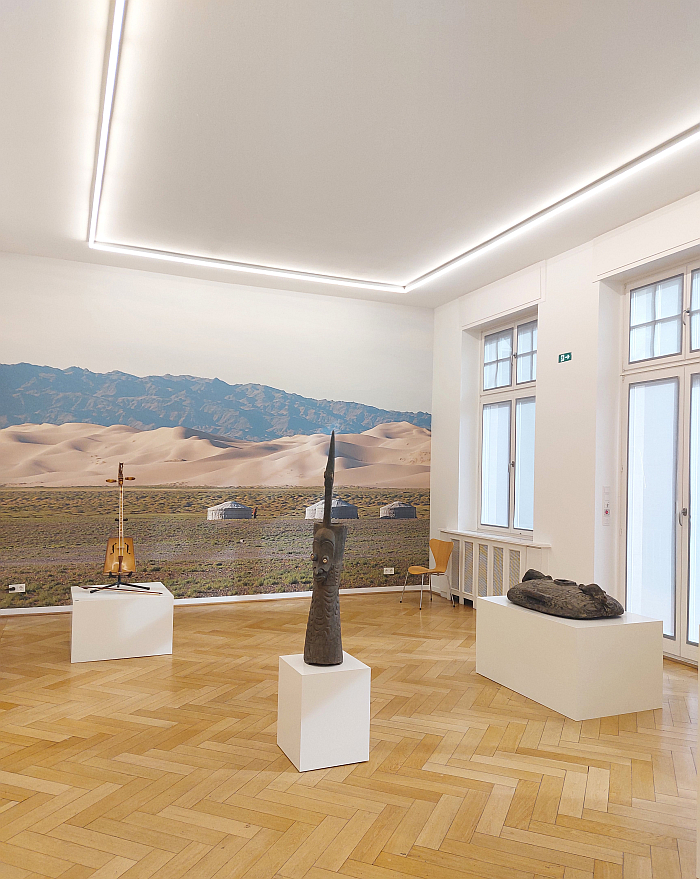
An accessible and logically designed exhibition which unfolds its narrative via short, succinct, comprehensible, bilingual German/English texts and via exhibits as varied as, for example, research by the Frankfurt (Main) based Max Planck Institute for Empirical Aesthetics on the question Music or not?, i.e. how noise is perceived, and the associated whys?, a so-called Jingle Dress associated with the Ojibwa of North America, cowbells, and varied and various instruments, including, for example, a water drum used in traditional ceremonies in New Guinea, an Indonesian kadedek, or the panpipes that most maligned and misunderstood of instruments. And also the drums and gongs of a Gamelan orchestra/ensemble, that music which also featured so centrally in Can You Hear It? Music and Artificial Intelligence at the Museum für Kunst und Gewerbe, Hamburg, albeit presented in Frankfurt as a conduit to a discussion on music and culture, music and perceptions of culture, and not as in Hamburg as a tool for both further segmenting and alienating human societies and also for training AI systems to aid and abet state sponsored oppression and repression.
An exhibition one is invited to listen to as much as view; many of the examples of sounds, music, noises are presented as audio to which one is invited to listen. An invitation we declined.
Specifically we declined the headphones offered to us on the way in. We fully believed the very pleasant, courteous, staff at the entrance that all the sets had been well cleaned, and we don't doubt they were; but we simply can't, won't, get over our aversion to putting something on our heads that has possibly been on the head of one of those individuals who leave vast, repugnant, patches of grease on bus and tram and train windows. Or dandruff on chair headrests. 'You'll be missing something', we were told. And we very well may have. But gladly. And not that we were aware of missing anything, whereby our focus was less the sounds as such as the whats, whys and wherefores of the sounds, the contexts; although we do happily accept that the visiting experience would have been very different, perhaps better even, if we had listened to the exhibition. But we had fun. If we were slightly distracted by the thought that in an age when everyone is permanently connected to their earphones/headphones there must surely be a simple solution for the provision of sound in exhibitions via a visitor's own technology. And if not we hope exhibition design technicians are working on it.
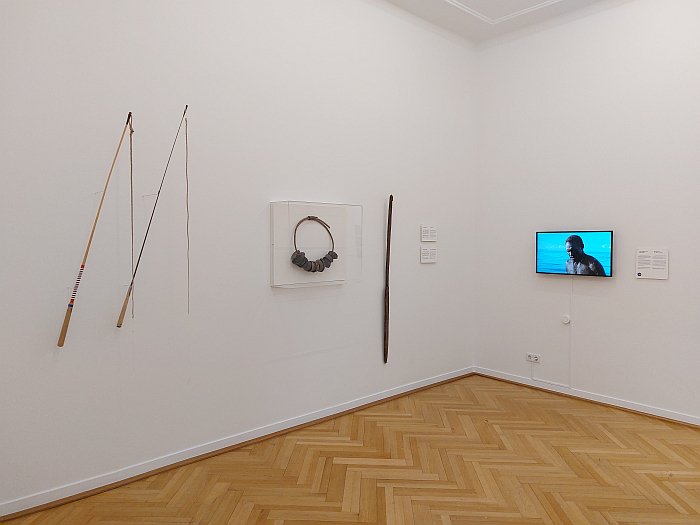
And an exhibition wherein yes, there is no escaping the fact that the context of the museum in which it is being staged and its collection cannot, shouldn't, mustn't, be ignored. We discussed the (hi)story of the Weltkulturen Museum, Frankfurt, and its collection from their exhibition Green Sky, Blue Grass. Colour Coding Worlds and so refer you there dear reader for our thoughts, and also refer you to the museum's website for their statements on their collection, its provenience and the wider (hi)story of the institution. For such is important, for all as opined above, in context of the genesis of such institutions and their role in shaping Eurocentric appreciations, understandings, of the world.
However, and equally important, Sound Sources isn't an exhibition whose focus is the peoples of Indonesia, Mongolia, 'New Ireland' et al, certainly not the peoples of Indonesia, Mongolia, 'New Ireland' et al in a fading black and white sepia view that could be surmised from the fading black and white sepia images, and far less an exhibition whose focus is a contrast between the peoples of Indonesia, Mongolia, 'New Ireland' et al and European societies; rather is an exploration of the relationships between 'noise' and human societies, the cultural and social contexts of 'noise', 'noise' as a cultural phenomenon, 'noise' as a universal but individual aspect of daily life.
And that from a global perspective that through its global perspective on the one hand very satisfyingly holds a mirror up to a contemporary Europe that devotes so much of its time to debating the 'values' of this or that people as distinct from the 'values' of that or this people, to celebrating (invariably invented) traditions by way of seeking to differentiate one group from other groups. A Europe that increasingly thinks of itself in a fading black and white sepia manner. Times change, people change, communities change and for all there is nothing wrong with remembering the past, indeed as a Tsuyoshi Tane admonishes we should remember the past, it's important that we remember the past, that isn't the same as living in that past. The Gumboot dancers of South Africa don't live in the past. Neither, we'd argue, do the tenun weavers of Flores. Nor the peoples of the Mongolian steppe. We're less sure of the Schuhplattler dancers, Goaßlschnalzen swingers and the cowbell fixated Alpine herders. And despite the colour popularly associated with it, what is 'Retro' in home furnishings if not a hanging on to the objects, the world view, of the past, interior design in a fading black and white sepia. Verner Panton designed for the world of tomorrow, there is nothing, but nothing, 'Retro' in his designs, to claim there is to fail to understand them. As is to design your home based on visuals alone. Or put another way, Sound Sources allows one to approach the question, what role does the past play in the today? Are you using the past to help frame questions or using the past as an answer? Key questions in contemporary Europe.
On the other hand a global perspective that allows for differentiated and more nuanced considerations and reflections on the difference(s) between 'sound' and 'music', on how 'noise' is perceived, understood, interpreted, liked or disliked, and the questions of why. Global questions of what is music. What is noise pollution.
And on the rare and thus all the more valuable third hand, a global perspective that through the insights it enables, thought process it stimulates and appreciations of the nature and basis our understandings of the world it opens, tends to an argument that we all need to be exposed more regularly to global soundscapes than we currently are, that we all need to explore the world aurally as well as visually, to explore the myriad same same but differents of global soundscapes.
Sound Sources is an easily accepted invitation to begin that process, and thereby to begin to discover beauty beyond your own music, to discover beauty beyond your own sounds. And thereby to begin to create new types of space, private and collective, domestic and public, political and cultural.
Sound Sources. Everything is Music! is scheduled to run at the Weltkulturen Museum, Schaumainkai 29-37, 60594 Frankfurt until Sunday September 1st.
Full details can be found at www.weltkulturenmuseum.de
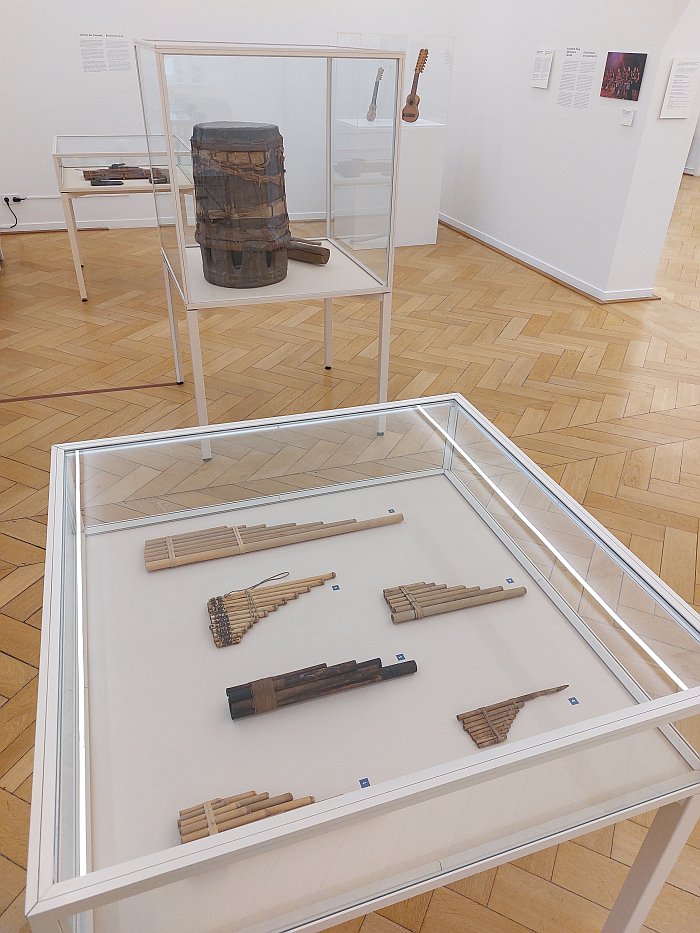
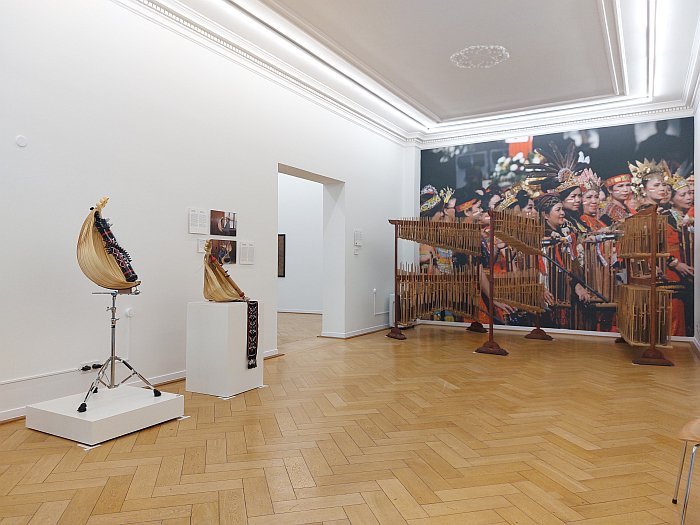
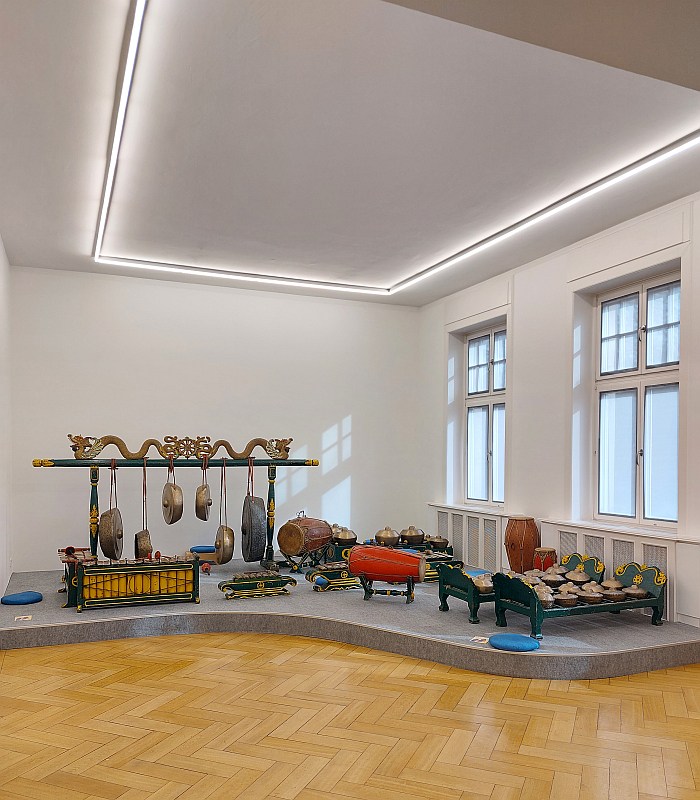
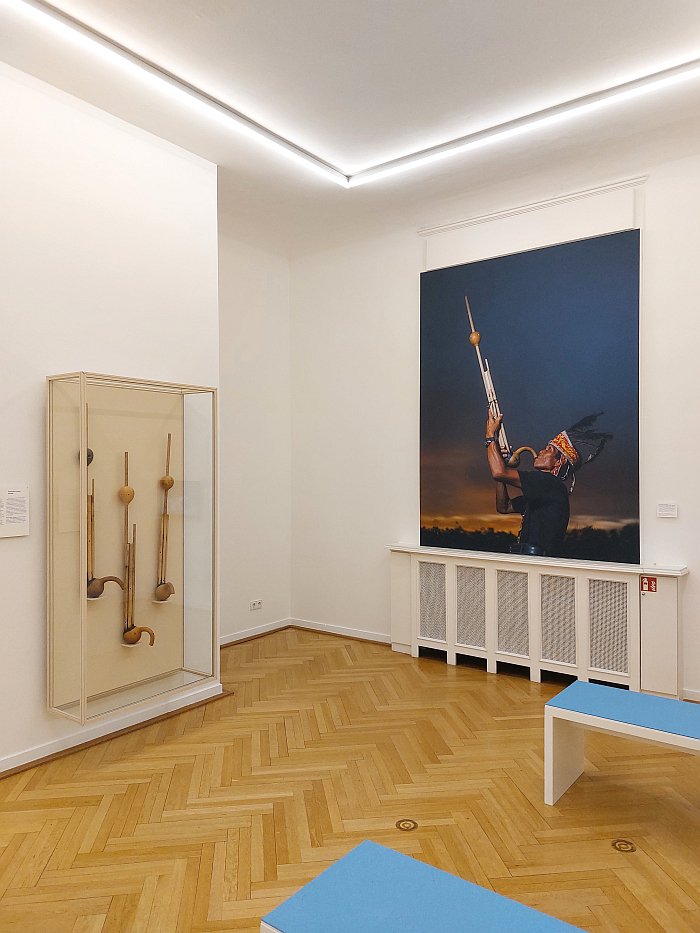
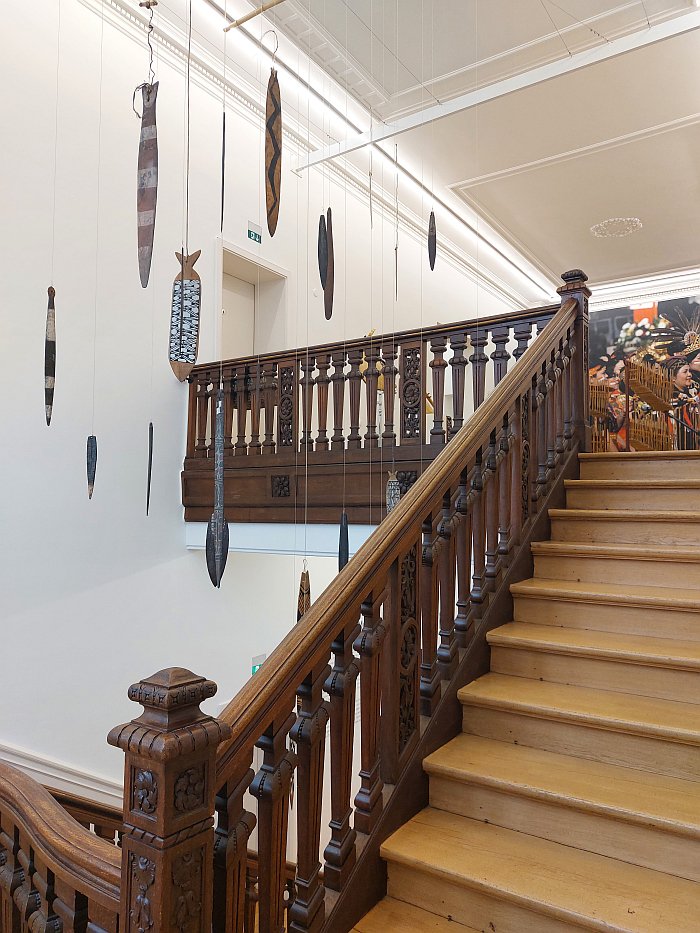
1part of a regularly held speech by Panton reprinted as, Verner Panton: Meine Design-Philosophie, BÜROszene, Vol 47, Nrs. 1–2, 1995
2In the interests of fairness, and correctness, the Conserve the Sound archive does feature a 1960s Monpti typewriter produced by Brno based Zbrojovka, but otherwise it is a western European sound memory that is preserved.